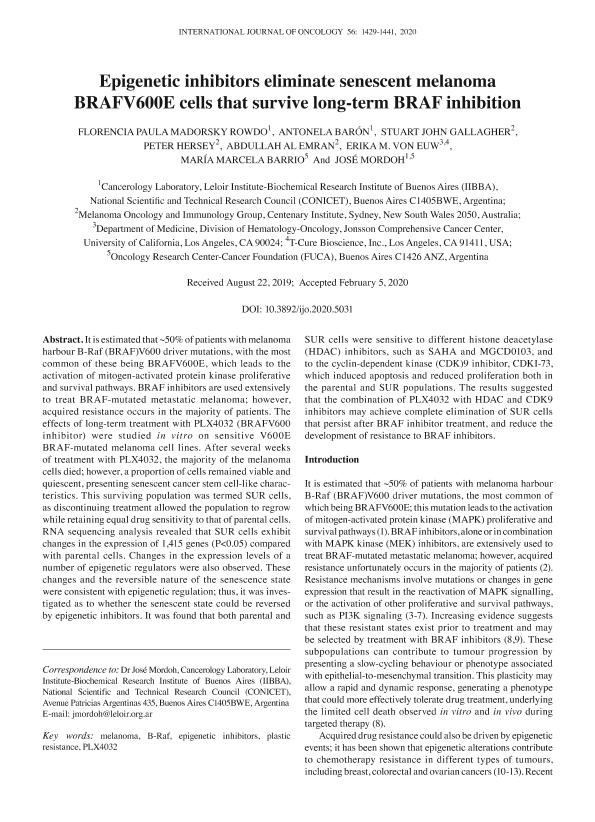Mostrar el registro sencillo del ítem
dc.contributor.author
Madorsky Rowdo, Florencia Paula

dc.contributor.author
Baron, Antonela

dc.contributor.author
Gallagher, Stuart John
dc.contributor.author
Hersey, Peter
dc.contributor.author
Emran, Abdullah A. L.
dc.contributor.author
Von Euw, Erika María

dc.contributor.author
Barrio, Maria Marcela

dc.contributor.author
Mordoh, Jose

dc.date.available
2022-09-15T12:48:37Z
dc.date.issued
2020-06
dc.identifier.citation
Madorsky Rowdo, Florencia Paula; Baron, Antonela; Gallagher, Stuart John; Hersey, Peter; Emran, Abdullah A. L.; et al.; Epigenetic inhibitors eliminate senescent melanoma BRAFV600E cells that survive long-term BRAF inhibition; Spandidos Publications; International Journal of Oncology; 56; 6; 6-2020; 1429-1441
dc.identifier.issn
1019-6439
dc.identifier.uri
http://hdl.handle.net/11336/168875
dc.description.abstract
It is estimated that ~50% of patients with melanoma harbour B-Raf (BRAF)V600 driver mutations, with the most common of these being BRAFV600E, which leads to the activation of mitogen-activated protein kinase proliferative and survival pathways. BRAF inhibitors are used extensively to treat BRAF-mutated metastatic melanoma; however, acquired resistance occurs in the majority of patients. The effects of long-term treatment with PLX4032 (BRAFV600 inhibitor) were studied in vitro on sensitive V600E BRAF-mutated melanoma cell lines. After several weeks of treatment with PLX4032, the majority of the melanoma cells died; however, a proportion of cells remained viable and quiescent, presenting senescent cancer stem cell-like characteristics. This surviving population was termed SUR cells, as discontinuing treatment allowed the population to regrow while retaining equal drug sensitivity to that of parental cells. RNA sequencing analysis revealed that SUR cells exhibit changes in the expression of 1,415 genes (P<0.05) compared with parental cells. Changes in the expression levels of a number of epigenetic regulators were also observed. These changes and the reversible nature of the senescence state were consistent with epigenetic regulation; thus, it was investigated as to whether the senescent state could be reversed by epigenetic inhibitors. It was found that both parental and SUR cells were sensitive to different histone deacetylase (HDAC) inhibitors, such as SAHA and MGCD0103, and to the cyclin-dependent kinase (CDK)9 inhibitor, CDKI-73, which induced apoptosis and reduced proliferation both in the parental and SUR populations. The results suggested that the combination of PLX4032 with HDAC and CDK9 inhibitors may achieve complete elimination of SUR cells that persist after BRAF inhibitor treatment, and reduce the development of resistance to BRAF inhibitors.
dc.format
application/pdf
dc.language.iso
eng
dc.publisher
Spandidos Publications

dc.rights
info:eu-repo/semantics/openAccess
dc.rights.uri
https://creativecommons.org/licenses/by-nc-nd/2.5/ar/
dc.subject
B-RAF
dc.subject
EPIGENETIC INHIBITORS
dc.subject
MELANOMA
dc.subject
PLASTIC RESISTANCE
dc.subject
PLX4032
dc.subject.classification
Otras Ciencias Biológicas

dc.subject.classification
Ciencias Biológicas

dc.subject.classification
CIENCIAS NATURALES Y EXACTAS

dc.title
Epigenetic inhibitors eliminate senescent melanoma BRAFV600E cells that survive long-term BRAF inhibition
dc.type
info:eu-repo/semantics/article
dc.type
info:ar-repo/semantics/artículo
dc.type
info:eu-repo/semantics/publishedVersion
dc.date.updated
2022-09-15T02:18:39Z
dc.identifier.eissn
1019-6439
dc.journal.volume
56
dc.journal.number
6
dc.journal.pagination
1429-1441
dc.journal.pais
Grecia

dc.journal.ciudad
Atenas
dc.description.fil
Fil: Madorsky Rowdo, Florencia Paula. Consejo Nacional de Investigaciones Científicas y Técnicas. Oficina de Coordinación Administrativa Parque Centenario. Instituto de Investigaciones Bioquímicas de Buenos Aires. Fundación Instituto Leloir. Instituto de Investigaciones Bioquímicas de Buenos Aires; Argentina
dc.description.fil
Fil: Baron, Antonela. Consejo Nacional de Investigaciones Científicas y Técnicas. Oficina de Coordinación Administrativa Parque Centenario. Instituto de Investigaciones Bioquímicas de Buenos Aires. Fundación Instituto Leloir. Instituto de Investigaciones Bioquímicas de Buenos Aires; Argentina
dc.description.fil
Fil: Gallagher, Stuart John. Centenary Institute; Australia
dc.description.fil
Fil: Hersey, Peter. Centenary Institute; Australia
dc.description.fil
Fil: Emran, Abdullah A. L.. Centenary Institute; Australia
dc.description.fil
Fil: Von Euw, Erika María. University of California at Los Angeles; Estados Unidos. Consejo Nacional de Investigaciones Científicas y Técnicas; Argentina
dc.description.fil
Fil: Barrio, Maria Marcela. Fundación Cáncer. Centro de Investigaciones Oncológicas; Argentina. Consejo Nacional de Investigaciones Científicas y Técnicas; Argentina
dc.description.fil
Fil: Mordoh, Jose. Fundación Cáncer. Centro de Investigaciones Oncológicas; Argentina. Consejo Nacional de Investigaciones Científicas y Técnicas. Oficina de Coordinación Administrativa Parque Centenario. Instituto de Investigaciones Bioquímicas de Buenos Aires. Fundación Instituto Leloir. Instituto de Investigaciones Bioquímicas de Buenos Aires; Argentina
dc.journal.title
International Journal of Oncology

dc.relation.alternativeid
info:eu-repo/semantics/altIdentifier/url/https://www.spandidos-publications.com/10.3892/ijo.2020.5031
dc.relation.alternativeid
info:eu-repo/semantics/altIdentifier/doi/http://dx.doi.org/10.3892/ijo.2020.5031
Archivos asociados
